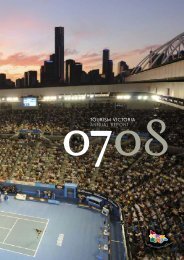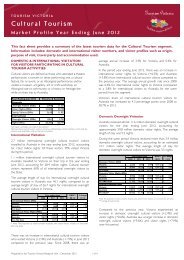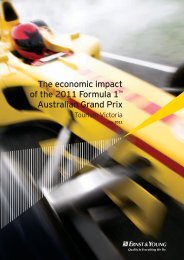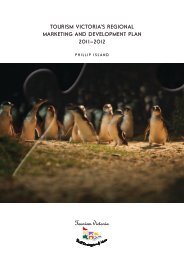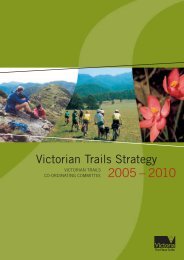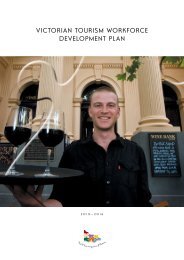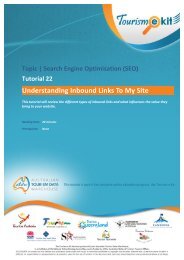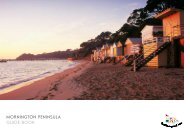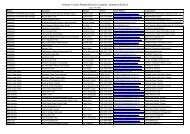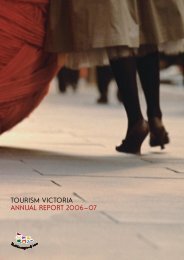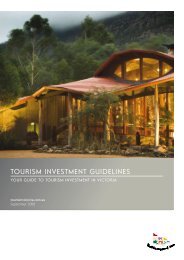Long Term Tourists or Short Term Migrants? - Tourism Victoria
Long Term Tourists or Short Term Migrants? - Tourism Victoria
Long Term Tourists or Short Term Migrants? - Tourism Victoria
Create successful ePaper yourself
Turn your PDF publications into a flip-book with our unique Google optimized e-Paper software.
1<br />
<strong>Long</strong> <strong>Term</strong> <strong>Tourists</strong> <strong>or</strong><br />
Sh<strong>or</strong>t <strong>Term</strong> <strong>Migrants</strong>?<br />
The Impact of International W<strong>or</strong>king Holiday<br />
Makers (WHMs) on the <strong>Tourism</strong> Economy of<br />
Mildura in Regional Vict<strong>or</strong>ia<br />
Research Summary: July 2009<br />
Photo: W<strong>or</strong>king Holiday Makers from Europe picking apples in the ‘Murray’ tourism region of Vict<strong>or</strong>ia<br />
Dr Jeff Jarvis & Dr Vict<strong>or</strong>ia Peel<br />
Graduate <strong>Tourism</strong> Program<br />
National Centre f<strong>or</strong> Australian Studies<br />
Monash University
2<br />
Research Summary<br />
Widely regarded as a key niche component of the total inbound backpacker<br />
market, the W<strong>or</strong>king Holiday Maker (WHM) is one of the fastest growing sub<br />
segments of international visitation to Australia. <strong>Long</strong> ‐ term independent<br />
travel has now become a widely accepted rite of passage f<strong>or</strong> young people<br />
and the WHM visa is a great facilitat<strong>or</strong> of this in Australia. 1 The WHM visa<br />
permits young international travellers aged between 18 and 30, from<br />
nineteen countries the right to w<strong>or</strong>k and travel in Australia f<strong>or</strong> up to 12<br />
months. A second 12 month visa available f<strong>or</strong> WHMs who have w<strong>or</strong>ked in<br />
specified professions (such as fruit picking) in regional Australia f<strong>or</strong> 90 days.<br />
Between 2004/05 and 2007/08 the number of WHM visas issued increased<br />
by 47.7%, from 104,000 to 154,000. Over the same time, international<br />
visitation to Australia increased by just 4.5% and significantly, ‘nonbackpacker’<br />
visitation increased by just 3.3%. 2 This growth in the popularity<br />
of the WHM visa runs counter‐cyclical to the sluggish international arrival<br />
trends evident in the Australian tourism industry in recent years. In response<br />
to this, <strong>Tourism</strong> Vict<strong>or</strong>ia has identified WHMs in their ‘Backpacker <strong>Tourism</strong><br />
Action Plan 2009 – 2013’ as the pri<strong>or</strong>ity backpacker sub ‐ segment f<strong>or</strong> the<br />
state. 3<br />
Why are W<strong>or</strong>king Holiday Makers imp<strong>or</strong>tant?<br />
WHMs are high yield visit<strong>or</strong>s to Australia and beneficial to total employment.<br />
A 2009 Department of Immigration and Citizenship study conducted by Tan<br />
et al estimated that each WHM spent $13,218 in Australia over an average 8<br />
month stay, with the total value of the segment estimated at $1.8 billion. In<br />
1 O’Reilly, C ‘From Drifter to Gap Year tourist: Mainstreaming Backpacker Travel’ Annals of <strong>Tourism</strong><br />
Research, Vol 33 (4) 2006, pp998‐1017<br />
2 <strong>Tourism</strong> Research Australia (TRA), International Visit<strong>or</strong> Survey. Superweb data, 2004/05 – 2007/08<br />
3 <strong>Tourism</strong> Vict<strong>or</strong>ia, ‘Backpacker <strong>Tourism</strong> Action Plan 2009 – 2013’ <strong>Tourism</strong> Vict<strong>or</strong>ia, Melbourne, 2009.<br />
p22
3<br />
addition, the study identified that every 100 WHMs arriving in Australia<br />
creates 6.3 full time jobs in the wider economy. 4<br />
There is a strong perceived c<strong>or</strong>relation between the WHM and the inbound<br />
backpacker. The national ‘backpacking industry’ assumes that the maj<strong>or</strong>ity<br />
of WHM visa holders will spend at least one night of their stay in hostel<br />
accommodation, thus classifying themselves as a ‘backpacker’ (under the<br />
definition used by <strong>Tourism</strong> Research Australia (TRA)). This assumption is<br />
further supp<strong>or</strong>ted by Tan et al who also noted that hostels were the most<br />
popular f<strong>or</strong>m of accommodation used by WHMs. 5<br />
The WHM segment however offers significant yield opp<strong>or</strong>tunities above that<br />
of the wider backpacker travel market. As shown in figures 1.1 and 1.2,<br />
recent growth in WHMs to Australia is over three times that of the whole<br />
backpacker market . 6<br />
Figure 1: WHM Visas issued 1983/84 – 2008/09<br />
200000<br />
150000<br />
100000<br />
WHM Visas<br />
50000<br />
0<br />
83/84 88/89 93/94 98/99 2003/04 2008/09<br />
(Source: Department of Immigration and Citizenship)<br />
4 Tan, Y, Richardson, S, Lester, L, Bai, T, Sun, L. ‘Evaluation of Australia’s W<strong>or</strong>king Holiday Maker<br />
(WHM) Program’ Department of Immigration and Citizenship, Canberra, 2009.<br />
5 Tan op cit pp IX<br />
6 Between 2004/05 and 2007/08, the segment increased by 15.6%.
4<br />
Figure 2: Backpacker Arrivals 1999/2000 – 2007/08<br />
600000<br />
500000<br />
400000<br />
300000<br />
200000<br />
Backpacker Arrivals<br />
100000<br />
0<br />
1999/2000 2001/02 2003/04 2005/06 2007/08<br />
(Source: <strong>Tourism</strong> Research Australia: Superweb)<br />
<strong>Tourism</strong> Research Australia (TRA) expenditure data estimated the economic<br />
value of the backpacker market in 2007/08 at $A3.095 billion. Theref<strong>or</strong>e it is<br />
estimated that around 58% of total backpacker expenditure was generated<br />
by WHMs in 2007/08.<br />
WHMs can theref<strong>or</strong>e be described as a fast growing subset of the high yield<br />
backpacker segment. Based on the assumption that all WHMs are<br />
backpackers, the market share of WHMs in the backpacker market has<br />
increased from 21.4% of total visitation in 2004/05 to 27.3% in 2007/08. It is<br />
likely that this growth will continue as preliminary data obtained from the<br />
Australian Department of Immigration indicates that in 2008/09 there was an<br />
increase of over 21% in the number of WHM visas issued, to 187,696. 7 (see<br />
Table 1.1)<br />
W<strong>or</strong>king Holiday Makers and the <strong>Tourism</strong> Economy<br />
On January 1 st 1975, Australia’s W<strong>or</strong>king Holiday Maker (WHM) program<br />
commenced as part of the general introduction of visas f<strong>or</strong> all international<br />
visit<strong>or</strong>s. In that first year approved countries comprised the UK, Canada and<br />
7 Department of Immigration. Preliminary data on WHM visas issued 2008/09. Unpublished data.
5<br />
Ireland. The principle objective of the scheme was to promote international<br />
understanding by enabling young people from other countries to experience<br />
Australian culture. 8 Visa holders were theref<strong>or</strong>e entitled to remain in<br />
Australia f<strong>or</strong> an extended period of time while they experienced closer<br />
contact with the community through incidental w<strong>or</strong>k. 9 By January 2009, the<br />
three initial partner countries had grown to nineteen 10 and a further four<br />
countries had signed a ‘w<strong>or</strong>k and holiday’ agreement. 11<br />
During 2005 and 2006, the WHM visa changed significantly. Firstly, the<br />
holder was permitted to increase the period of w<strong>or</strong>k with one employer from<br />
3 months to 6 months. 12 Secondly, WHMs could apply f<strong>or</strong> a second 12 month<br />
visa if they spent 90 days w<strong>or</strong>king in specified jobs in rural Australia. 13 In<br />
addition, in February 2007 regional construction jobs were able to qualify the<br />
applicant f<strong>or</strong> a second WHM visa. These changes had a significant bearing on<br />
the travel behaviour of this segment and demand f<strong>or</strong> the visa.<br />
The WHM visa has been a recent success st<strong>or</strong>y f<strong>or</strong> the Australian tourism<br />
industry with numbers increasing from 64,973 in 1998/99 to 187,696 in<br />
2008/09. (See table 1.1) <strong>Tourism</strong> Australia has responded to this growth by<br />
developing specific campaigns promoting Australia as a ‘w<strong>or</strong>king holiday’<br />
destination in key markets including the UK, K<strong>or</strong>ea, France and Germany. 14<br />
8 Rep<strong>or</strong>t on the joint standing committee on Migration “W<strong>or</strong>king Holiday Makers: M<strong>or</strong>e than tourists’<br />
Australian Government Publishing Service, Canberra, 1997, pp 8<br />
9 Ibid<br />
10 The WHM Visa countries are: UK, Germany, Sweden, Finland, N<strong>or</strong>way, Denmark, Estonia, Belgium,<br />
Netherlands, Canada, Cyprus, France, Hong Kong, Ireland, Italy, Japan, K<strong>or</strong>ea, Malta, Taiwan. (as at<br />
January 2009)<br />
11 The “W<strong>or</strong>k and Holiday Visa” is similar to the WHM visa except it is only available to tertiary<br />
educated students and those that have sufficient English language skills. It is also only available f<strong>or</strong> 12<br />
months and cannot be extended by 90 days rural w<strong>or</strong>k. As of January 2009 this was available to 18‐30<br />
year olds from Chile, Thailand, Turkey and the USA. (http://www.immi.gov.au/visit<strong>or</strong>s/w<strong>or</strong>kingholiday/462/)<br />
12 Implemented in July 2006<br />
13 Implemented November 2005<br />
14 <strong>Tourism</strong> Australia Website, Howell, D. Presentation to BTAP Conference 15 June 2009.<br />
http://www.tourism.australia.com/content/Marketing%20Resources/Youth%20BTAP%2015%20June<br />
%2009.pdf (accessed 20/7/09)
6<br />
Photo: <strong>Tourism</strong> Australia’s on‐line (MySpace) campaign f<strong>or</strong> the WHM visa in the UK 2009<br />
(Source: <strong>Tourism</strong> Australia website)<br />
Table 1.1: Australian WHM visas issued 2007/2008 & 2008/2009<br />
(Source: Department of Immigration and Citizenship, 2008 & 2009)<br />
Rank WHM Visa Country Visas issued<br />
2007/08<br />
Visas issued<br />
2008/09*<br />
1 United Kingdom 34,147 40,182<br />
2 K<strong>or</strong>ea 32,629 39,506<br />
3 Germany 17,450 20,319<br />
4 Ireland 17,119 22,786<br />
5 France 11,013 16,250<br />
6 Japan 10,605 9,324<br />
7 Canada 8,089 8,737<br />
8 Taiwan 6,132 9,240<br />
9 Sweden 3,912 4,398<br />
10 Netherlands 3,591 3,988<br />
11 Italy 3,567 4,632<br />
12 Hong Kong (SAR<br />
1,533 2,715<br />
China)<br />
13 Denmark 1,142 1,220<br />
14 Belgium 977 1,223<br />
15 Finland 928 1,060<br />
16 N<strong>or</strong>way 694 727<br />
17 Estonia 520 1,248<br />
18 Malta 93 97<br />
19 Cyprus 5 25<br />
Other 35 19<br />
TOTAL 154,181 187,696<br />
* Indicates preliminary data from the Department of Immigration and Citizenship 2009
7<br />
The strategic implications of the 2005/06 visa amendments are twofold.<br />
Firstly, it made WHMs m<strong>or</strong>e attractive to hire as they could be employed f<strong>or</strong><br />
6 months by one employer, thus expanding the pool of available jobs.<br />
Secondly, the lure of the second visa encouraged WHMs to disperse m<strong>or</strong>e<br />
throughout Australia. As well as providing the opp<strong>or</strong>tunity to spend m<strong>or</strong>e<br />
time in regional Australia, WHMs could now stay in the country f<strong>or</strong> two<br />
years, thus spreading their economic benefits further.<br />
Photo: A sign placed outside a hostel in the Mildura region offering backpackers f<strong>or</strong> hire.<br />
In the context of these changes, this study expl<strong>or</strong>es the tourism behaviour<br />
and contribution of WHM visa holders to regional Australia, via a study on<br />
their impact on the tourism economy of the regional Vict<strong>or</strong>ian city of<br />
Mildura.<br />
WHMs are clearly an imp<strong>or</strong>tant component of the overall international<br />
visit<strong>or</strong> mix to Australia yet they have received little scrutiny either from<br />
industry <strong>or</strong> in academic tourism literature. With regard to academic<br />
research, Hansen and Bell have noted in their study of seasonal migration<br />
within Australia, that the WHM is principally observed in relation to ‘w<strong>or</strong>king<br />
conditions, w<strong>or</strong>ker recruitment difficulties and labour sh<strong>or</strong>tages’. 15 Studies<br />
15 Hanson, J. and Bell, M. ‘Harvest trails in Australia: Patterns of seasonal migration in the fruit and<br />
vegetable industry’, Journal of Rural Studies, 23 (2007), pp.101‐117. p.103
8<br />
which focus the WHM within a tourism context are few. Allon et.al, Bushell<br />
and Anderson, and Clarke observed the WHM experience in the urban<br />
environment of Sydney, the main international gateway f<strong>or</strong> the nation. 16<br />
Bushell and Anderson note that high spending w<strong>or</strong>king holiday makers are<br />
having an impact beyond the traditional backpacker hostel;<br />
‘It is clear that Sydney is attracting a growing number of cashed up<br />
w<strong>or</strong>king holiday makers who are a lot m<strong>or</strong>e affluent and don’t mind<br />
paying a bit extra to get individual rooms with an en‐suite’. 17<br />
Clarke, Hansen and Bell and Allon et.al each situate their analysis of WHMs<br />
within the diversity of contemp<strong>or</strong>ary patterns of mobility. Clarke describes<br />
British WHMs as both ‘travelling‐in‐dwelling’ and ‘dwelling‐in‐travelling’.<br />
Allon et.al also found that:<br />
‘the w<strong>or</strong>king holiday in particular blurs traditional understandings of<br />
both the touristic holiday and the everyday w<strong>or</strong>ld of w<strong>or</strong>k and routine<br />
to become an unusual kind of residential experience that combines<br />
periods of travelling through place with periods of dwelling in place’.<br />
W<strong>or</strong>king Holiday Makers in Mildura<br />
In March 2009, a research team from Monash University led by Dr Jeff Jarvis<br />
and Dr Vicki Peel conducted a quantitative research study with 171 w<strong>or</strong>king<br />
holiday maker visa holders in the regional Vict<strong>or</strong>ian city of Mildura. The pilot<br />
research study was a jointly funded <strong>Tourism</strong> Vict<strong>or</strong>ia and National Centre f<strong>or</strong><br />
Australian Studies (Monash University) initiative that is part of an upcoming<br />
national Australian Research Council (ARC) – Linkage research grant<br />
application on the impact of WHMs on regional Australia f<strong>or</strong> 2010 – 2013.<br />
This was the first ever study of WHMs undertaken in a regional Australian<br />
context.<br />
16 Allon, F, Anderson, K, and Bushell, R. ‘Mutant Mobilities: Backpacker <strong>Tourism</strong> in Global Sydney’,<br />
Mobilities, Vol 3, (1) 2008. Clarke, N., ‘Detailing Transnational Lives of the Middle: British W<strong>or</strong>king<br />
Holiday Makers in Australia’, Journal fo Ethnic and Migration Studies, 31 (2), march 2005, pp.307‐322.<br />
17 Bushell, R and Anderson, K ‘A clash of cultures <strong>or</strong> definitions? Complexity and backpacker tourism in<br />
residential communities’ in Hannam, K and Diekmann, A Beyond Backpacker <strong>Tourism</strong>: Mobilities and<br />
Experiences, Channel View Publications, Cleverdon, 2009. p291
9<br />
Located on the Vict<strong>or</strong>ian side of the Murray River b<strong>or</strong>der, Mildura was<br />
selected as the pilot research study destination as a number of previous<br />
studies have documented the attraction of the city to WHMs f<strong>or</strong> w<strong>or</strong>k<br />
purposes. 18 Virtual year‐round employment is available f<strong>or</strong> WHMs in a range<br />
of agricultural pursuits (mostly associated with fruit harvesting) and a<br />
number of ‘backpacker’ providers have emerged to meet the<br />
accommodation needs of the market. The city is also now serviced by budget<br />
airlines from Sydney and Melbourne which improves the connectivity of the<br />
destination to the main East Coast backpacker trail.<br />
Using a qualitative judgemental sampling methodology, the survey<br />
population was interviewed face‐to‐face. The research was conducted during<br />
March 2009 within accommodation establishments within the region. The<br />
key findings from the research study are as follows;<br />
Key Research findings<br />
(A) The Impact of WHMs on Mildura<br />
• Mildura is clearly identified as a ‘w<strong>or</strong>k’ destination by the market with<br />
97% of the sample visiting the town only to secure employment.<br />
• On average the WHM visa holders in the sample were long stay<br />
visit<strong>or</strong>s, planning to stay in Mildura f<strong>or</strong> 8 weeks (56 nights), with an<br />
average planned stay in Vict<strong>or</strong>ia of 93 nights.<br />
• WHMs are estimated to make a significant contribution to the<br />
domestic economy of Mildura, spending on average $57.31 per night,<br />
$401.17 per week and $1604.68 per month. With the average stay<br />
18 <strong>Tourism</strong> Research Australia (TRA) data highlights that the tourism region of the “Mallee” (which<br />
includes Swan Hill and Mildura) accounted f<strong>or</strong> over 278,000 ‘backpacker nights’ spent within Vict<strong>or</strong>ia<br />
(and outside of Melbourne) in 2007.<strong>Tourism</strong> Research Australia (TRA), International Visit<strong>or</strong> Survey.<br />
Superweb data, 2007. See also the 2009 study of WHMs in Australia by Tan, Richardson, Lester, Bai<br />
and Sun, which identified the Mildura region as a maj<strong>or</strong> ‘w<strong>or</strong>king region’ f<strong>or</strong> WHMs and Hanson and<br />
Bell, op.cit.
10<br />
being just under 8 weeks, each WHM in Mildura is estimated to be<br />
w<strong>or</strong>th just over $3192 to the region.<br />
• The maj<strong>or</strong>ity of this expenditure was spent within the local economy<br />
on accommodation (35.2%) and food and drinks from supermarkets<br />
(23.2%) <strong>or</strong> food and drinks from local cafes/restaurants (10.4%).<br />
• Expenditure on tours <strong>or</strong> activities is notably slight. Anecdotal<br />
observational evidence suggested that few if any ‘backpacker style’<br />
leisure products were promoted to the segment within the hostel<br />
environment.<br />
• The paucity of WHM travel to outlying regions is exhibited in the high<br />
percentage that stay only in Mildura (91.7%) with just 8.3% taking<br />
either a day <strong>or</strong> overnight trip beyond the city.<br />
• In total the ‘tourism inf<strong>or</strong>mation provision sect<strong>or</strong>’ both within and<br />
outside of Mildura was only used by 22.5% of the sample with the<br />
hostel taking on a m<strong>or</strong>e imp<strong>or</strong>tant role (23.7%). Clearly this highlights<br />
an inf<strong>or</strong>mation provision breakdown between the existing tourism<br />
inf<strong>or</strong>mation providers and the WHM market. This then potentially<br />
creates an inf<strong>or</strong>mation ‘void’ if hostels only provide limited tourism<br />
related inf<strong>or</strong>mation on the region.<br />
(B) Who are the WHMs in Mildura?<br />
• The sample of w<strong>or</strong>kers interviewed was primarily young, with an<br />
average age of 22.7 years, with 76% being under 25 years of age. (The<br />
average f<strong>or</strong> all WHM visas issued being 69.5% under 25 years of<br />
age) 19 The sample was also dominated by Europeans, with the UK,<br />
Germany, Ireland and France accounting f<strong>or</strong> 76% of the total.<br />
19 Department of Immigration. WHMs Issuance by Age, 2005/2006. Unpublished data.
11<br />
• Respondents’ education level reflected a tendency to travel at the<br />
end of a completed course of education (secondary <strong>or</strong> tertiary).<br />
However, over one third of the population were ‘career breakers’<br />
with a significant number having quit their job and a smaller<br />
prop<strong>or</strong>tion having taken leave without pay in <strong>or</strong>der to travel.<br />
• The desire to travel bef<strong>or</strong>e taking on a career and other adult<br />
responsibilities was a strong motivation f<strong>or</strong> the sample population of<br />
WHMs (73.4%).<br />
• Only 60% of the sample self defined themselves as ‘backpackers’ with<br />
17% preferring the title ‘independent traveller’ and a further 14%<br />
preferring a combination of ‘Independent traveller – backpacker’. The<br />
implication here is that the ‘badge’ of being a backpacker is losing its<br />
currency in the market.<br />
• Just over half the respondents agreed that extended travel was<br />
regarded as beneficial f<strong>or</strong> young people in their home countries<br />
(53.2%).<br />
(C) Attitudes to w<strong>or</strong>k and the WHM visa<br />
• Over one third (36.1%) felt strongly that Australia’s WHM visa offer<br />
was a significant inducement to take an extended trip from home.<br />
• The opp<strong>or</strong>tunity to extend their WHM visa by an additional year by<br />
w<strong>or</strong>king in regional Australia appears to be a strong motivation<br />
amongst the sample, with 66% intending to do so. In addition to this a<br />
further 15% of those surveyed had already applied f<strong>or</strong> a second WHM<br />
visa, so a total of 81% of the WHMs in the sample had already <strong>or</strong><br />
wanted to extend their visa. This finding indicates that the lure of a<br />
second visa is encouraging backpackers to seek w<strong>or</strong>k in Mildura and<br />
regional destinations and thus stimulates greater dispersion.
12<br />
• Almost three quarters of the survey felt strongly that the WHM<br />
provided a good way to ‘experience m<strong>or</strong>e of the country’ than if they<br />
had arrived as a tourist (73.4%) and the WHM visa ‘enabled a closer<br />
experience of the Australian lifestyle’ (69.2%).<br />
• There was strong supp<strong>or</strong>t f<strong>or</strong> the statement that this f<strong>or</strong>m of travel<br />
was beneficial to personal development (71.6%) and that it permitted<br />
maximum traveling freedom (71%).<br />
• The ‘social contacts’ aff<strong>or</strong>ded by WHM travel was identified as<br />
imp<strong>or</strong>tant as over three quarters of the survey believed it was ‘a good<br />
way to meet other travellers’ (75.7%). Almost two thirds (62.8%) were<br />
also strongly motivated by the ‘good party atmosphere’ provided by<br />
travelling in this f<strong>or</strong>m.<br />
• Overall a mix of inf<strong>or</strong>mation sources were used to find w<strong>or</strong>k, with ‘the<br />
hostel’ proving to be the most popular with 57% of the sample using<br />
it to identify employment opp<strong>or</strong>tunities. In addition, 46% identified<br />
opp<strong>or</strong>tunities via friends and 44% used the Australian Government’s<br />
‘Harvest jobs’ site.<br />
• A number of WHMs complained that there was not enough w<strong>or</strong>k<br />
available f<strong>or</strong> them in the Mildura region, and often they had to wait<br />
around f<strong>or</strong> jobs to come up. Concerns were also raised about<br />
inc<strong>or</strong>rect inf<strong>or</strong>mation being given to them regarding the availability of<br />
jobs.<br />
• During their time in Australia WHMs are clearly adaptable with many<br />
undertaking not just manual labour/fruit picking jobs, but also<br />
‘bar/retail/café’ w<strong>or</strong>k and general ‘sales’ w<strong>or</strong>k. In considering their<br />
interest in future jobs, 64% were interested in further fruit picking,<br />
while 48% were interested in bar <strong>or</strong> retail w<strong>or</strong>k.
13<br />
• Career based professional w<strong>or</strong>k was undertaken by just 4.8% of the<br />
WHMs surveyed. However it is significant that m<strong>or</strong>e than a quarter of<br />
WHMs expressed interest in undertaking this kind of w<strong>or</strong>k in future<br />
(26%).<br />
• Almost one third of the sample of WHMs would consider applying f<strong>or</strong><br />
permanent residency in Australia as a result of their experience.<br />
(D) Travel Patterns in Australia<br />
• The researchers were able to identify that WHMs segment<br />
destinations in Australia into three sub categ<strong>or</strong>ies acc<strong>or</strong>ding to their<br />
primary motivation to visit; (a) w<strong>or</strong>k, (b) w<strong>or</strong>k/leisure <strong>or</strong> (c) pure<br />
leisure. Their behaviour in and theref<strong>or</strong>e their associated impact upon<br />
each destination is an area w<strong>or</strong>thy of future research.<br />
• WHMs follow traditional backpacker routes around Australia with the<br />
East Coast states of Vict<strong>or</strong>ia, NSW and Queensland dominating their<br />
intended visitation patterns.<br />
• The average expected length of stay of the WHMs sample is<br />
significantly higher than the average stay f<strong>or</strong> all backpackers at 365<br />
days (<strong>or</strong> 1 year) compared to 73 nights in Australia. (It should be<br />
noted here that the strong interest in applying f<strong>or</strong> the additional<br />
‘WHM extension’ year in Australia, increases the average).<br />
• There is an indication of WHMs stimulating additional visitation to<br />
Australia through VFR. Almost half (47%) claimed that they had been<br />
visited by friends <strong>or</strong> relatives whilst on their WHM visa during their<br />
stay.<br />
Study Conclusions
14<br />
From a national perspective, the study has identified that the availability of<br />
the WHM visa is an attractive stimulant f<strong>or</strong> many young people to visit<br />
Australia. In addition, the lure of the second 12 month WHM visa motivates<br />
many travellers to seek w<strong>or</strong>k in regional Australia thus increasing their<br />
dispersion throughout the country where they make a significant<br />
contribution to regional tourism economies.<br />
An opp<strong>or</strong>tunity f<strong>or</strong> the Australian tourism industry theref<strong>or</strong>e exists to build<br />
on this success of the WHM visa and attract increasing numbers of young<br />
travellers.<br />
The research also identified that over 36% of travellers in the sample were<br />
taking a ‘career break’ to use the visa. If Australia is interested in expanding<br />
this market, extending the upper age limit from 30 to 35 could provide<br />
increased numbers of cashed up ‘career breakers’ with the opp<strong>or</strong>tunity to<br />
travel on a WHM visa. This would also provide access to the visa f<strong>or</strong> the<br />
growing ‘flashpacker’ market as noted by Hannam and Diekmann.<br />
‘The so called flashpacker has emerged as a new and key constituent<br />
of contemp<strong>or</strong>ary travel and exemplifies the changing demographics in<br />
western societies where older age at marriage, older age of having<br />
children, increased affluence, and new technological developments,<br />
alongside increased holiday and leisure time have all come<br />
together’. 20<br />
The study also identified high satisfaction with the WHM visa (despite the<br />
difficult job market) with 73% willing to recommend their friends to travel in<br />
Australia as a WHM and only 11% of the sample having no intention to<br />
return to Australia and 49% intending to return within 5 years. By providing<br />
WHM visa holders with the opp<strong>or</strong>tunity of obtaining a second visa after<br />
spending a minimum of 12 <strong>or</strong> 24 months back in their home country, such a<br />
policy would permit young WHMs who might have used the visa straight<br />
20 Hannam, K. and Diekmann, A. ‘From Backpacking to Flashpacking: Developments in backpacker<br />
tourism research’ in in Hannam, K and Diekmann, A (eds) Beyond Backpacker <strong>Tourism</strong>: Mobilities and<br />
Experiences, Channel View Publications, Cleverdon, UK, 2009. p12
15<br />
after completing school to return later in their 20s. Such modifications to the<br />
overall program could expand the number of visas issued and theref<strong>or</strong>e the<br />
associated economic benefits.<br />
As f<strong>or</strong> finding w<strong>or</strong>k while on the WHM visa, the research identified that only<br />
26% found it easy to find w<strong>or</strong>k and only 35% found it easy to search f<strong>or</strong> w<strong>or</strong>k<br />
in Australia. Given the timing of the study during the global financial crisis,<br />
such a result was not unexpected. Interviews conducted by the researchers<br />
with growers and hostel owners in Mildura indicated that many WHMs were<br />
currently willing to take jobs f<strong>or</strong> 2‐ 3 months at a time. This Irish backpacker<br />
sums up the situation well.<br />
“It (the WHM visa) is pretty good as it is. It is a pity there are not m<strong>or</strong>e jobs<br />
around. But there is not much we can do about the economy, I suppose.”<br />
18 year old Irish male<br />
The study identified that WHM travellers use a variety of means to seek<br />
employment, including hostel, internet sites and face to face meetings.<br />
Clearly there is a degree of confusion amongst WHMs on how to find w<strong>or</strong>k as<br />
the following quotes from British WHMs highlight.<br />
“I found it difficult to find employment in a field that I wanted (office w<strong>or</strong>k). I<br />
also felt that there was a lot of false advertising (false promises of a base<br />
wage, when in fact it was only commission based) and jobs listed under<br />
wrong titles, especially the ‘marketing’ jobs.<br />
25 year old UK Male<br />
“A reliable website on jobs f<strong>or</strong> WHMs needed. One that you do not have to<br />
pay to join! Sometimes employers attempt to hire you on false promises, e.g.<br />
that you would be paid when you wouldn’t. Some guidelines and m<strong>or</strong>e<br />
inf<strong>or</strong>mation <strong>or</strong> advice on the availability of jobs is urgently needed.”<br />
22 year old UK female<br />
From a regional perspective, the study identified that the WHM visa and the<br />
availability of the second WHM visa (after w<strong>or</strong>king 90 days in regional<br />
Australia) drives international visit<strong>or</strong> dispersion away from the gateway cities<br />
and to Mildura with 97% of the WHMs interviewed only coming to the city to<br />
w<strong>or</strong>k. Theref<strong>or</strong>e Mildura currently plays a significant role in assisting the
16<br />
dispersion of backpacker nights and expenditure within Vict<strong>or</strong>ia and outside<br />
of Melbourne as it attracts a significant number of long staying, high yielding<br />
visit<strong>or</strong>s. Data from <strong>Tourism</strong> Research Australia (TRA) identifies that<br />
approximately 54% of all international visit<strong>or</strong> nights in the city are<br />
attributable to ‘backpackers’ the maj<strong>or</strong>ity of whom would be WHMs. 21<br />
The study identified that the mobility of WHMs around Australia is motivated<br />
by their desire to find w<strong>or</strong>k <strong>or</strong> leisure opp<strong>or</strong>tunities. Theref<strong>or</strong>e destinations<br />
in Australia can be segmented into either (a) primary w<strong>or</strong>k destinations (b)<br />
both w<strong>or</strong>k and leisure destinations and (c) primary leisure destinations.<br />
Further research is required on this aspect of WHM mobility to evaluate their<br />
impact on each categ<strong>or</strong>y of destination.<br />
The arrival of the WHMs in a regional destination such as Mildura also<br />
stimulates industry development. Although this research study did not look<br />
specifically at supply side issues, it was observed that a viable backpacker<br />
hostel industry has established in the region in response to the seasonal<br />
w<strong>or</strong>k opp<strong>or</strong>tunities available.<br />
However, despite the proximity of key tourism attractions such as the<br />
Murray river, the outback town of Broken Hill and the w<strong>or</strong>ld heritage site of<br />
Mungo National Park being, there is a lack of suitable tour product<br />
development such as the small ‘WHM/backpacker tours’ that are typically<br />
found in backpacker leisure destinations. A number of travellers bemoaned<br />
the lack of ‘something to do’ outside of their w<strong>or</strong>king hours in Mildura:<br />
“Travellers need to have better pay, and there needs to be m<strong>or</strong>e to do in<br />
Mildura, especially f<strong>or</strong> backpackers”<br />
19 year old Italian male<br />
An opp<strong>or</strong>tunity theref<strong>or</strong>e exists f<strong>or</strong> the city of Mildura. If it wishes to further<br />
harness the benefits from hosting ‘w<strong>or</strong>king’ WHMs, the city should aim to<br />
21<br />
‘<strong>Tourism</strong> Profiles f<strong>or</strong> Local Government Areas in Regional Australia: Mildura Rural City’, Canberra,<br />
March 2008, <strong>Tourism</strong> Research Australia.
17<br />
become a regional hub and ‘gateway to the outback’. This can be achieved by<br />
building on the existing ‘w<strong>or</strong>k focused’ infrastructure and by increasing the<br />
‘leisure’ product options available within the wider region in both NSW and<br />
Vict<strong>or</strong>ia. This would then increase the length of stay and regional economic<br />
impact of the existing WHMs as well as potentially attracting additional<br />
backpackers f<strong>or</strong> leisure activities.<br />
Further Inf<strong>or</strong>mation on the researchers at the National Centre f<strong>or</strong> Australian Studies at Monash<br />
University.<br />
Dr Jeff Jarvis has an industry background in international marketing and advertising and has<br />
developed an international research reputation in the high yielding segment of independent travellers<br />
and backpacker tourism following the publication of ‘The Billion Dollar Backpackers’ in the mid 1990s.<br />
Recently he was invited by the United Nations W<strong>or</strong>ld <strong>Tourism</strong> Organization (UN‐WTO) to present on<br />
the strategic role independent travellers can play in the development of nations.<br />
Contact: (Jeff.Jarvis@arts.monash.edu.au)<br />
Dr Vict<strong>or</strong>ia Peel has a research reputation in the combined fields of Australian Studies and <strong>Tourism</strong>,<br />
with particular emphasis on Cultural <strong>Tourism</strong>, Regional <strong>Tourism</strong> Development, the Backpacker and<br />
Student <strong>Tourism</strong> markets. Dr Peel’s research themes have consistently addressed the issues of<br />
hist<strong>or</strong>ical and contemp<strong>or</strong>ary educational and youth travel experiences<br />
Contact: .(Vicki.Peel@arts.monash.edu.au)<br />
NB: This pilot study was co‐funded by <strong>Tourism</strong> Vict<strong>or</strong>ia and the National Centre f<strong>or</strong> Australian Studies<br />
at Monash University.(www.arts.monash.edu.au/ncas) It f<strong>or</strong>ms part of an application f<strong>or</strong> further<br />
research funding f<strong>or</strong> an expanded national study from the Australian Research Council (ARC) under<br />
the ‘industry linkage’ scheme.



